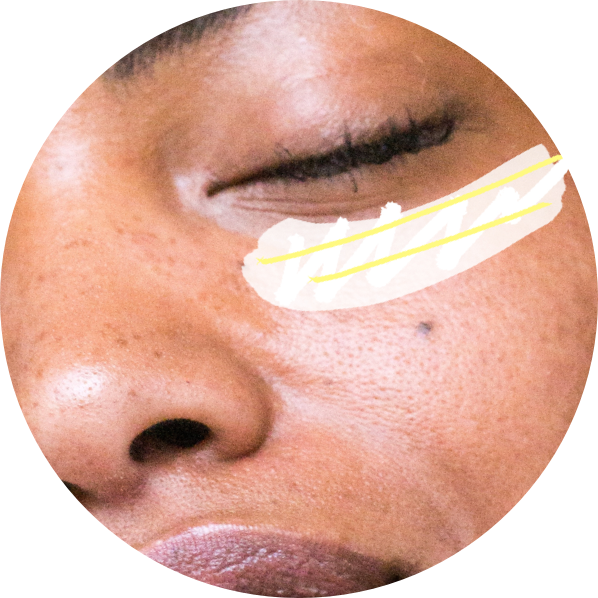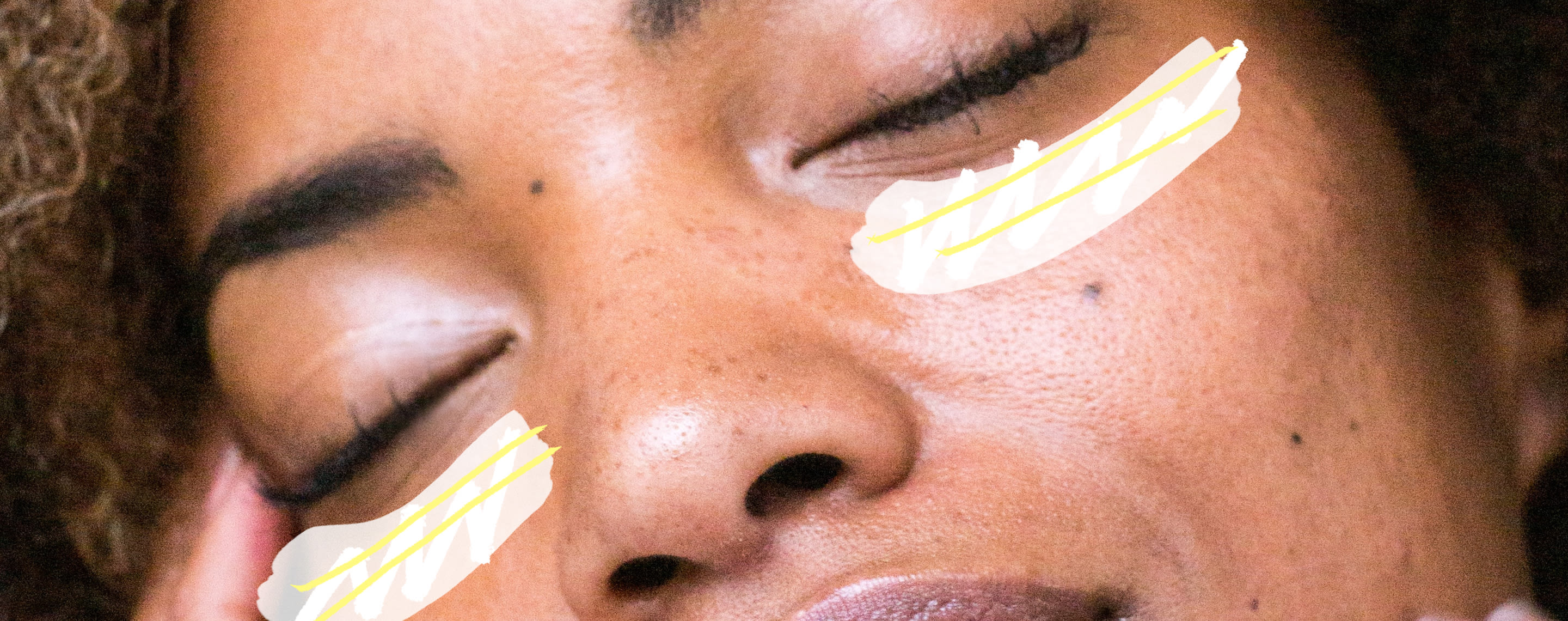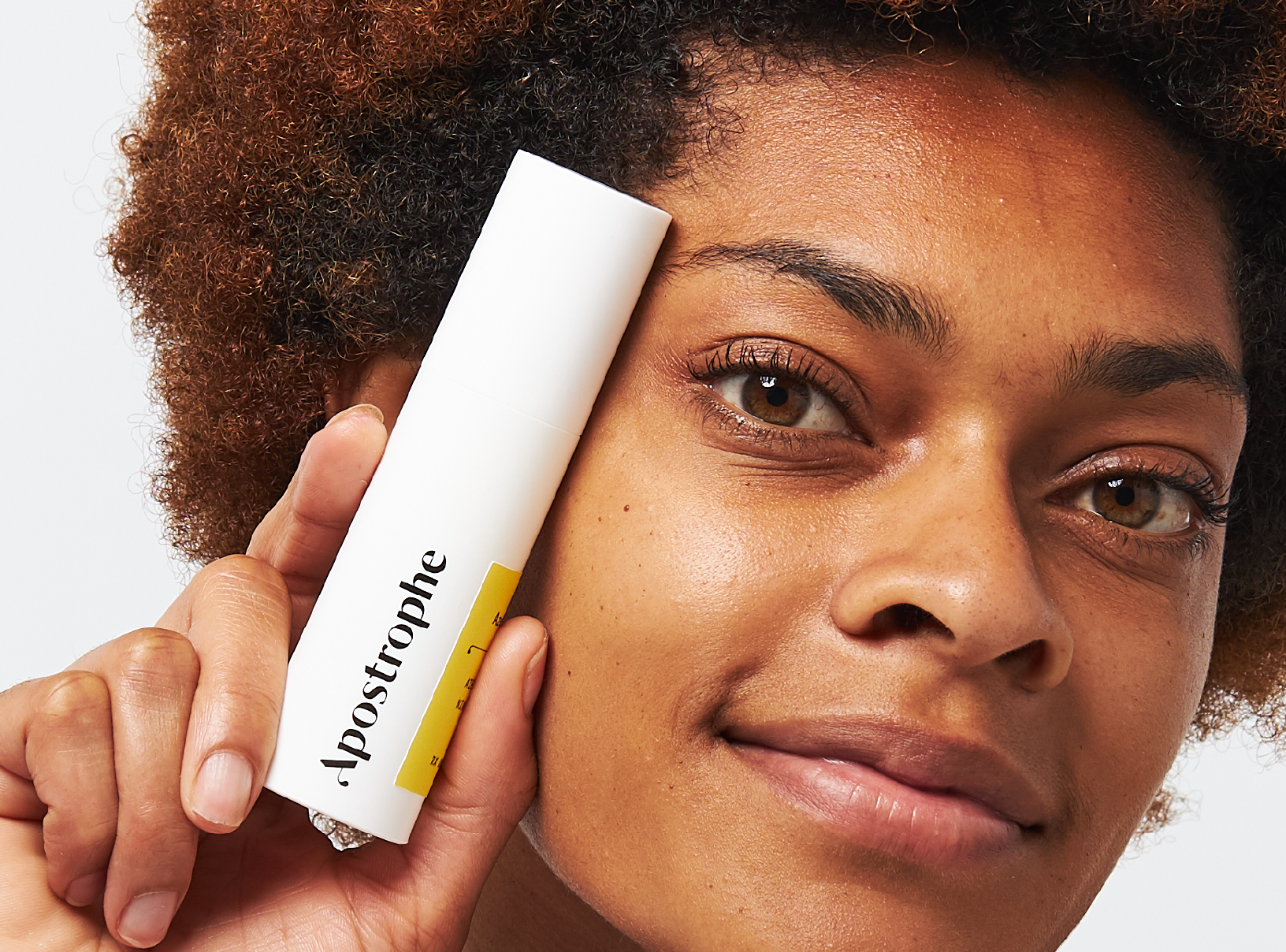Education
Do eye creams work?


SHARE
Education
Do eye creams work?
Medically reviewed by Katelyn Hagerty FNP
Written by Apostrophe Team
Last updated 4/1/2024
Walk down the aisle in any drugstore and you’ll find yourself face to face with a smorgasbord of skin products. Acne creams, body scrubs, foot masks, face massagers—you name it.
While it might take more than a single blog post to cover the intricate details of all of the products you need (and don’t need), we’re dedicating this one to a single skincare product—eye creams.
We’ll answer your pressing questions, like whether or not it works, what you might need it for, and even how to apply an eye cream.
Let’s jump in.
What is the Purpose of Eye Cream?
The skin around our eyes is some of the thinnest on our body, making it especially sensitive to environmental factors, aging, and harsh products.
Therefore, choosing a product that is specifically formulated for this area of the face can be pivotal in caring for your skin over time.
Eye creams are available for all sorts of purposes, including moisturizing, anti-aging, SPF protection, and more. Let’s talk about the ingredients you should look for to meet your specific needs.
What Ingredients Should You Look For in Eye Creams?
Eye creams come loaded with all sorts of ingredients in them, formulated for the particularly thin and delicate skin around your eyes.
Different ingredients also serve different purposes for different uses, which is why knowing what is in your eye cream is just as important as knowing why you want an eye cream.
Here are some of the ingredients you’re likely to find in various eye creams, as well as what they help treat.
You’ll notice that there are a few duplicates mentioned throughout (namely, vitamins E and C), but that’s because they serve a few important purposes.
Hyaluronic Acid and Ceramides
The skin around your eyes is some of the thinnest on your body, making it more prone to dryness and irritation.
Ingredients like hyaluronic acid and ceramides will help keep your skin moisturized.
As an added bonus, properly moisturizing skin helps reduce the appearance of wrinkles.
Antioxidants Like Vitamin C, Vitamin E, and Ferulic Acid
Unlike some other parts of your body, the skin on your face spends most of its time exposed to the elements.
Antioxidants will help fortify your skin against damage-causing free radicals—since your skin’s ability to resist this particular type of damage lessens as you age.
Look for antioxidant ingredients like vitamin C, vitamin E, and ferulic acid.
Retinols
In your face alone, there are forty-two individual muscles.
Wrinkles and fine lines due to the constant flexing of your facial muscles over the years, along with sagging skin, fatty tissue deposits, the hollowing of the eye socket and weakening of muscles are all natural effects of aging. This isn’t a reason to stop smiling, though.
Eye creams containing retinol, a medication derived from vitamin A, stimulates collagen production to reduce and prevent fine lines and wrinkles, with the added benefit of unclogging pores, as well.
Peptides
As your skin ages, it will progressively lose collagen and elasticity, with many women beginning to notice such changes in their forties.
If you notice sagging or a crinkly look akin to crepe paper on the skin around your eyes, peptides are the active ingredient you’re looking for.
They increase collagen and elastin in order to firm up your skin.
Caffeine
There are a variety of causes of under eye puffiness and under-eye bags, from lack of sleep, to dehydration and aging. To address this issue, look for eye creams containing retinol, caffeine or vitamin C.
Kojic Acid and Azelaic Acid
We’re sorry to report that there’s no “quick fix” for this one.
Dark circles on the under-eye area can be caused by a number of factors, including thinning skin and hyperpigmentation.
Hyperpigmentation is the only cause of dark circles that can be treated with the topical ingredients you’ll find in eye creams. Look for ingredients like vitamins C and E, kojic acid, and azelaic acid.
For lighter skin tones, retinol can also be an effective treatment. However, it can also have the effect of furthering hyperpigmentation on darker tones.
SPF
To protect the skin on your face from the sun, a face-specific block is totally fine to use all over your face. However, you’ll also find eye creams with that extra boost of SPF protection.
Either will do fine but the most important thing is to make sure you don’t forgo sun protection altogether, especially since some of the ingredients on this list (like retinoids) mayl make your skin more sensitive to the sun.
You can give your eyes some additional protection by wearing sunglasses, as well.
Tips for Choosing an Eye Cream
As you’ve probably noticed, eye creams are available in abundance, from a variety of different brands and at a wide selection of price points.
Here are some do’s and don’ts for purchasing an eye cream that works for your skin:
Do choose a formulation that works for your skin. As with any skin care product, you’ll want to choose the correct formulation for your skin. For example, if you have oily skin, an oil-free product might be the best choice for you.
Don’t use too many eye creams at once. If you’re aiming to address a specific issue with the skin around your eyes, choose a product that covers your top concern and give it time to work—you can use one eye cream for daytime and another for night. Using too many products at once can cause irritation.
Do look for words like “hypoallergenic,” “non-comedogenic,” and “non-acnegenic.” Respectively, these products are less likely to cause allergic reactions to sensitive skin, do not clog pores and do not cause acne.
Don’t break your wallet. A high price tag doesn’t automatically mean a product will work—there are effective eye creams at a variety of price ranges. Check the ingredient label and find a cream that has ingredients that target the symptoms you’re aiming to treat.
Do keep your expectations realistic. If it sounds too good to be true, it probably is. No product is going to make you look 10 years younger overnight.
Don’t choose a product with strong scents. The skin around our eyes is very delicate, and strong scents, pampering as they may seem, can be irritating.
Do test your products. This goes without saying for any topical skin care product, but try a little and then ramp up from there once you have an idea of how your skin is responding.
Don’t use expired products. We recommend using a marker on your product packaging to be aware of when you opened your skin products. For example, SPF protection only remains viable for six months after the product has been opened.
How Do I Properly Apply Eye Cream?
Just as eye cream is an important part of your skincare routine, the way you apply it is equally important.
Once you’ve found a product that is a good match for your skin, you’ll want to be careful while applying it to make sure that you don’t cause any trauma to your skin surface.
Here’s what we recommend for applying eye cream:
Apply eye cream before your facial moisturizer. The jury is out on this one, but we recommend applying your eye cream before your moisturizer. This gives the skin around your eyes the best chance of absorbing the more delicate product formulated specifically for that area.
Apply in the morning and at night. Unless you’re getting sweaty, to reduce irritation you should keep face washing to twice a day, in the morning and at night. These are also the ideal times to apply eye cream.
Use a pea-sized amount. As with many products, a little goes a long way. You don’t want to risk getting the product into your eyes because you’ve applied too much, and you also don’t want to irritate the skin.
Don’t get too close. You may wonder where to apply eye cream. Apply the product around your eyes, but don’t get too close to avoid getting it in your eyes.
Tap, don’t rub. You’ll want to be gentle with the skin around your eyes since it is quite delicate. Use your ring finger to apply the product, this will provide the gentlest touch. Once you’ve dotted the product around your eyes, gently tap to help it sink in.
Let it rest. Once you’ve applied your eye cream, give it some time — about a minute — to absorb before you move on with your moisturizer and any makeup.
The Bottom Line
Eye cream can be a valuable addition to your skincare routine, and there are a variety of formulations to match your specific needs.
Whether you’re looking to prevent or reduce the appearance of fine lines and wrinkles, add some extra moisture, or protect your skin from the sun, you’ll have no issue finding something that fits your needs.
Schedule a consultation with a dermatology provider if you’re looking for some extra guidance in choosing the correct product.
References:
Hello bright eyes! How to pick the eye cream that’s right for you. (2019, May 16). Cleveland Clinic. Retrieved from https://health.clevelandclinic.org/hello-bright-eyes-how-to-pick-the-eye-cream-thats-right-for-you/
Poljšak, B., & Dahmane, R. (2012). Free radicals and extrinsic skin aging. Dermatology research and practice, 2012, 135206. Retrieved from https://www.ncbi.nlm.nih.gov/pmc/articles/PMC3299230/
Eveleth R. (2014, February 4). Human faces might only express four basic emotions. Smithsonian magazine. Retrieved from https://www.smithsonianmag.com/smart-news/human-faces-might-only-express-four-basic-emotions-180949598/
Crepey skin? a surprising cause — and 4 expert fixes. (2019, October 2). Cleveland Clinic. Retrieved from https://health.clevelandclinic.org/whats-causing-your-crepey-skin-and-how-can-you-fix-it/
The best options for droopy eyelids, circles and sags. (2019, June 3). Cleveland Clinic.Retrieved from https://health.clevelandclinic.org/the-best-options-for-droopy-eyelids-circles-and-sags/
Sumita, J. M., Leonardi, G. R., & Bagatin, E. (2017). Tretinoin peel: a critical view. Anais brasileiros de dermatologia, 92(3), 363–366. Retrieved from https://www.ncbi.nlm.nih.gov/pmc/articles/PMC5514577/
Act your age when it comes to skin care. (2016, Nov 1). American academy of dermatology association. Retrieved from https://www.aad.org/news/age-and-skin-care
Understanding the ingredients in skin care products. (2019, October 10). Cleveland Clinic. Retrieved from https://my.clevelandclinic.org/health/articles/10980-understanding-the-ingredients-in-skin-care-products
How to get rid of bags under your eyes. (2021, April 28). Cleveland Clinic. Retrieved from https://health.clevelandclinic.org/how-to-get-rid-of-bags-under-your-eyes/
Park, K. Y., Kwon, H. J., Youn, C. S., Seo, S. J., & Kim, M. N. (2018). Treatments of Infra-Orbital Dark Circles by Various Etiologies. Annals of dermatology, 30(5), 522–528. Retrieved from https://www.ncbi.nlm.nih.gov/pmc/articles/PMC7992473/
Retinoid or retinol? (2021, May 25). American academy of dermatology association. Retrieved from https://www.aad.org/public/everyday-care/skin-care-secrets/anti-aging/retinoid-retinol
Skin care in your 40s and 50s. (2021, May 25). American academy of dermatology association. Retrieved from https://www.aad.org/public/everyday-care/skin-care-basics/care/skin-care-in-your-40s-and-50s
Skin care tips dermatologists use. American Academy of Dermatology Association. Retrieved from https://www.aad.org/public/everyday-care/skin-care-basics/care/skin-care-tips-dermatologists-use
How to select anti-aging skin care products. American Academy of Dermatology Association. Retrieved from https://www.aad.org/public/everyday-care/skin-care-secrets/anti-aging/selecting-anti-aging-products
When should you toss your makeup? (2021, January 13). Cleveland Clinic. Retrieved from https://health.clevelandclinic.org/when-should-you-toss-your-makeup/
Face washing 101. American Academy of Dermatology Association. Retrieved from https://www.aad.org/public/everyday-care/skin-care-basics/care/face-washing-101
Like what you just read? Sign up for our email list to get the scoop on skincare science delivered straight to your inbox.

Deep Dives
A dermatologist shares his thoughts on the recent studies about benzoyl peroxide and benzene.
Read More
Education
What is milia?
What is milia? Today, we’re jumping into one type of bump that you may have heard about most commonly in infants — milia.
Read More
Education
Best moisturizer for acne-prone skin
If you have combination acne-prone skin, figuring out which moisturizer is best for your skin might be tough. In this guide, we break down the best moisturizer for combination, acne-prone skin.
Read More
